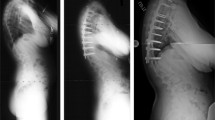Abstract
Introduction
Prader–Willi syndrome (PWS) represents a difficult challenge for spine surgeons, due to the association of a structural scoliosis, with a prevalence between 15 and 86%. Conservative therapy is a viable option, but surgery is increasingly becoming the treatment of choice.
Methods
The authors reviewed a series of 15 patients affected by PWS treated at their institution between 2008 and 2023. The mean age at index treatment was 9 years and 3 months (range 1–15 years) with a prevalence of female subjects. Primary scoliotic curve ranged from 14 to 102°, and mean thoracic kyphosis was 56° (range 20–75°). Eleven patients underwent conservative treatment, while four were treated surgically.
Results
Mean follow-up was 5 years and 3 months (range 2–12 years). Among the 11 patients treated conservatively, only two showed improvements of the coronal curve, while the remaining nine displayed a worsening of the deformity during follow-up. Complication rate after surgery was 75%. One patient developed paraplegia after pedicle screw positioning. One patient displayed rod breakage and PJK that required revision surgery proximally. Hardware deep infection was seen in one case where it was necessary to proceed with instrumentation removal after 10 years.
Discussion and conclusions
Spine surgery represents a convincing option in patients affected by PWS, but the risks of complications are high. Correct patient selection must be the main objective, and multilevel pedicle screw fixation should be the procedure of choice. Traditional growing rod should be prudently evaluated in every single case.




Similar content being viewed by others
References
Fraccaro M, Zuffardi O, Buhler EM, Jurik LP (1977) 15/15 Translocation in Prader-Willi syndrome. J Med Genet 14(4):275–276. https://doi.org/10.1136/jmg.14.4.275
Cassidy SB, Driscoll DJ (2009) Prader-Willi syndrome. Eur J Hum Genet 17:3–13. https://doi.org/10.1038/ejhg.2008.165
Whittington JE, Holland AJ, Webb T, Butler J, Clarke D, Boer H (2001) Population prevalence and estimated birth incidence and mortality rate for people with Prader-Willi syndrome in one UK Health Region. J Med Genet 38:792–798. https://doi.org/10.1136/jmg.38.11.792
Smith A, Egan J, Ridley G, Haan E, Montgomery P, Williams K, Elliott E (2003) Birth prevalence of Prader-Willi syndrome in Australia. Arch Dis Child 88:263–264. https://doi.org/10.1136/adc.88.3.263
Butler MG, Thompson T (2000) Prader-Willi syndrome: clinical and genetic findings. Endocrinologist 10:3S-16S. https://doi.org/10.1097/00019616-200010041-00002
Holm VA, Cassidy SB, Butler MG, Hanchett JM, Greenswag LR, Whitman BY, Greenberg F (1993) Prader-Willi syndrome: consensus diagnostic criteria. Pediatrics 91(2):398–402
Greggi T, Martikos K, Lolli F, Bakaloudis G, Di Silvestre M, Cioni A, Brodano GB, Giacomini S (2010) Treatment of scoliosis in patients affected with Prader-Willi syndrome using various techniques. Scoliosis 5:11. https://doi.org/10.1186/1748-7161-5-11
Nakamura Y, Murakami N, Iida T, Ozeki S, Asano S, Nohara Y, Nagai T (2015) The characteristics of scoliosis in Prader-Willi syndrome (PWS): analysis of 58 scoliosis patients with PWS. J Orthop Sci 20:17–22. https://doi.org/10.1007/s00776-014-0651-y
Kroonen LT, Herman M, Pizzutillo PD, Macewen GD (2006) Prader-Willi syndrome: clinical concerns for the orthopaedic surgeon. J Pediatr Orthop 26:673–679. https://doi.org/10.1097/01.bpo.0000226282.01202.4f
van Wijngaarden RD, de Klerk LW, Festen DA, Hokken-Koelega AC (2008) Scoliosis in Prader–Willi syndrome prevalence effects of age gender body mass index lean body mass and genotype. Arch Dis Child 93:1012–1016. https://doi.org/10.1136/adc.2007.123836
Tan HL, Urquhart DS (2017) Respiratory complications in children with Prader Willi syndrome. Paediatr Respir Rev 22:52–59. https://doi.org/10.1016/j.prrv.2016.08.002
Butler MG, Manzardo AM, Heinemann J, Loker C, Loker J (2017) Causes of death in Prader-Willi syndrome: Prader-Willi syndrome association (USA) 40-year mortality survey. Genet Med 19:635–642. https://doi.org/10.1038/gim.2016.178
Grugni G, Crino A, Bosio L, Corrias A, Cuttini M, De Toni T, Di Battista E, Franzese A, Gargantini L, Greggio N et al (2008) The italian national survey for Prader-Willi syndrome: an epidemiologic study. Am J Med Genet A 146A:861–872. https://doi.org/10.1002/ajmg.a.32133
van Bosse HJP, Butler MG (2020) Clinical observations and treatment approaches for scoliosis in Prader-Willi syndrome. Genes (Basel) 11(3):260. https://doi.org/10.3390/genes11030260
Gondoni LA, Vismara L, Marzullo P, Vettor R, Liuzzi A, Grugni G (2008) Growth hormone therapy improves exercise capacity in adult patients with Prader-Willi syndrome. J Endocrinol Invest 31:765–772
Yamada K, Miyamoto K, Hosoe H, Mizutani M, Shimizu K (2007) Scoliosis associated with Prader-Willi syndrome. Spine J 7:345–348. https://doi.org/10.1016/j.spinee.2006.05.017
Berven SH, Lowe T (2007) The scoliosis research society classification for adult spinal deformity. Neurosurg Clin N Am 18:207–213. https://doi.org/10.1016/j.nec.2007.03.002
Nixon GM, Brouillette RT (2002) Sleep and breathing in Prader-Willi syndrome. Pediatr Pulmonol 34:209–217. https://doi.org/10.1002/ppul.10152
Crinò A, Armando M, Crostelli M, Mazza O, Bruzzese D, Convertino A, Fintini D, Bocchini S, Ciccone S, Sartorio A, Grugni G (2022) High prevalence of scoliosis in a large cohort of patients with Prader-Willi syndrome. J Clin Med 11(6):1574. https://doi.org/10.3390/jcm11061574.PMID:35329900;PMCID:PMC8953215
Author information
Authors and Affiliations
Corresponding author
Ethics declarations
Conflict of interest
The authors declare no conflict of interest.
Additional information
Publisher's Note
Springer Nature remains neutral with regard to jurisdictional claims in published maps and institutional affiliations.
Rights and permissions
Springer Nature or its licensor (e.g. a society or other partner) holds exclusive rights to this article under a publishing agreement with the author(s) or other rightsholder(s); author self-archiving of the accepted manuscript version of this article is solely governed by the terms of such publishing agreement and applicable law.
About this article
Cite this article
Andaloro, A.A., Bari, L.J., Becchetti, F. et al. Scoliosis and rare diseases: our experience with the Prader–Willi syndrome. Eur Spine J (2024). https://doi.org/10.1007/s00586-024-08247-0
Received:
Revised:
Accepted:
Published:
DOI: https://doi.org/10.1007/s00586-024-08247-0




